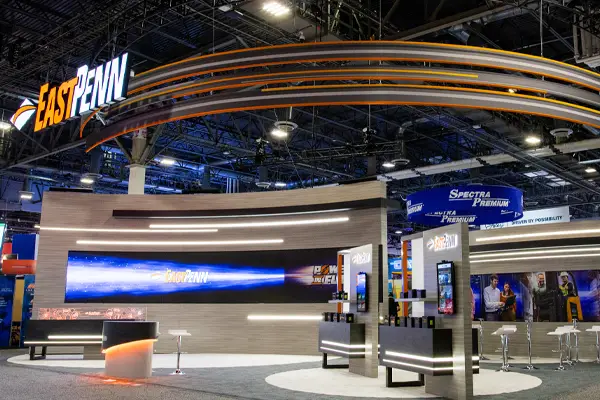[hubspot type=cta portal=20503845 id=786ce61c-d305-4b87-97f1-924377a4a52e]
Video walls are impressive. They make an impact. They attract attention. In short: they can be a great benefit to any exhibit.
Like any element of a display, if a video wall is not utilized thoughtfully, it will just become noise. You need to know the intent of a video wall before you can implement one successfully. How will a video wall improve your display and the message you are trying to convey? The video wall needs to be a meaningful part of your exhibit to be the most effective.
Here are eight questions to answer to ensure that your video walls for trade show exhibits help you stand out from the crowd.
https://youtu.be/AgLINF4XUyI
How much space do you have?
The answer to this question is crucial. You have to understand your space to comprehend how a video wall will impact it and how the available space affects your needs. For example, flat-panel LCDs and LEDs are very narrow and can be mounted on a wall. However, projection systems will need several feet of “floor space” to function.
[adguru adid="4635"]
Also, you don’t want to dominate a smallish exhibit space with a massive video wall. It will come across as off-putting to potential visitors. Have you ever seen Apple’s 1984 ad? It’ll feel like that. Be sure your video wall choice complements your space.
Where will the video wall be in your display?
Where you want the video wall to be displayed will influence the products you select. You need to consider the size and weight of your screens as well as the sturdiness and strength of the area where the screens will be hung or secured.
For example, hung or flown video walls are best viewed from a distance of 12 feet or more. While these displays are undoubtedly dramatic, not every exhibit has this kind of space. Those who don’t may want to opt for a ground supported wall, where it is preferable to be viewed from three to 12 feet, or a mounted wall, which should be viewed from five feet or less.
Also, where your video wall will be seen will impact the resolution you need. Another way to think of a display’s resolution is how many pixels it has per inch of screen. More pixels mean a clearer picture. But it is not always necessary to have the crispest picture, because how close someone will get to your screens will also dictate the size of the screen’s pixels. For example, an interactive display will use tiny pixels (1.2mm to 2.6mm) because they are intended to be viewed from a distance of three feet or less, while most other displays that are meant to be seen from three to 15 feet away can use slightly larger pixels (2.6mm to 3.9mm).
How much ambient light is in the area?
Just as a light entering your living room can affect how well you can see your TV, the ambient light in the area around your display will have an impact on how well attendees can see it.
The more brightness that your video wall produces, the better you can combat the glare that may otherwise affect your guests’ enjoyment. Be sure to pay attention to any nearby windows (their size doesn’t matter – even a shaft of light can still remove an hour of usefulness) and all overhead lighting. If you think it could be an issue, get some screens that are bright enough to combat the problem and avoid your guests having to strain their eyes.
[hubspot type=cta portal=20503845 id=786ce61c-d305-4b87-97f1-924377a4a52e]
What will be displayed on your video wall?
Will the media be constantly playing, or will it be triggered when people approach the screens? Will the content be mirrored (meaning the same material is shown on multiple displays) or extended (when one video plays out across several screens)?
If you want to have people interact with the screens, where do the touchscreens need to be located? How do you want the interactivity to work? How many people would like to be able to interact with your content at a single time?
Also, how would you like to control what is being displayed? You could elect to manage content from a laptop, through a tablet, or from a nearby kiosk.
[adguru adid="4635"]
Finally, it is incredibly important to remember that this content will likely need to be changed to suit upcoming shows. So, be sure to build in some flexibility for what your future needs could be.
How large does your video wall need to be?

This is a fun question because it also relates to the intent of your content. Do you want content that informs viewers or attracts passersby?
If you want content that is attractive, loud, and fun, you likely want a large video wall to display vivid images and is easily spotted from across the show floor. You will need some flashy graphics that move in a way that draws people toward your display.
A flown wall works nicely because it is already an attention-grabbing feature. Or you can forgo traditional square video walls with Digital Display Blocks. These modular blocks are efficient options because they can be stacked or hung on walls without any special rigging or custom-built walls. In fact, they can be easily integrated into just about any structure or environment. With Digital Display Blocks, there are unlimited design options possible, including steps, arches, S-curves, columns, stripes, or really any other geometric shape. The blocks can also be seated at different depths to create a 3D look and feel.
However, if you want the content to be informative – and maybe include elements that need to be read – your wall will likely need to be smaller and closer to the ground. Make sure that you get displays with smallish pixels. If people are going to need to read your content, you want details that are clear and legible.
Large screen kiosks, like the Chiosco Touchscreen Kiosk, are an excellent option for interactive content and engaging attendees during times when your exhibit has more visitors than staff. These kiosks are ideal for attracting a crowd because they are stylish, functional, and can be positioned anywhere in an exhibit, as long as an electrical plug is nearby. The structure can also be fully branded to increase brand awareness.
How is the power being supplied?
When you are ordering your electrical services from the show facility, make sure to include everything in your display that will need electricity. This is how the electricians know where to place the electrical drops.
Every show has a deadline for ordering electrical services. If you make it, you’ll receive electricity at a discounted rate. Miss the deadline, and you may pay as much as 50 percent more than you would have.
You will need to submit a scaled electrical floor plan that lists precisely where all of your power needs are located. Be sure to label the front of your display clearly – it would be unfortunate (and costly) should everything be installed backward. Clearly label where your video wall will be, what its power needs are, and how many outlets you require.
What’s your budget?
For most, renting a video wall is the most economical option, especially if it is only going to be used once or twice a year.
If you plan to utilize a video wall several times throughout a year, it may make sense to purchase one. However, there are many considerations when it comes to video walls. It’s not just the initial cost of the display, you need to consider the cost of shipping, install and dismantle, power consumption, and storage, plus maintenance, repairs, and the cost to ultimately replace it.
[hubspot type=cta portal=20503845 id=4b793ac3-dd4a-4b04-8a9d-d24ec93291d7]
Some video wall solutions appear very cost-effective – but that is without factoring in all of the costs above. Before deciding to purchase, do some research to ensure it’s the correct solution for you.
[adguru adid="4635"]
What are your future plans?
If purchasing a video wall (instead of renting), to save yourself trouble – and money – down the line, be sure to plan for your future needs. A solution that is highly integrated or needs a lot of specialized parts is not going to be very adaptable. Whereas, something that is modular and software-based, should provide flexibility when your needs change.
[hubspot type=cta portal=20503845 id=786ce61c-d305-4b87-97f1-924377a4a52e]
A video wall can bring a new dimension to an exhibit, and there are a variety of options designed to fit every need and budget. For even more information about our video wall solution, give The Trade Group a call at 800-343-2005.








